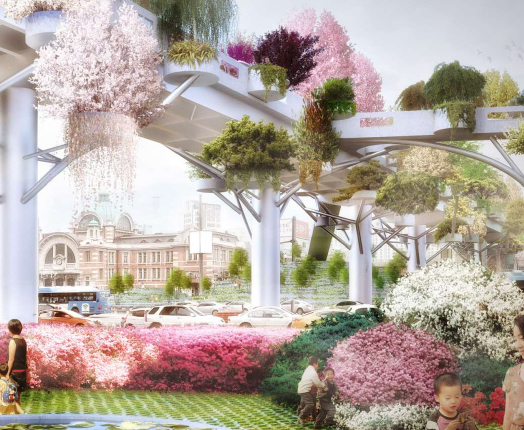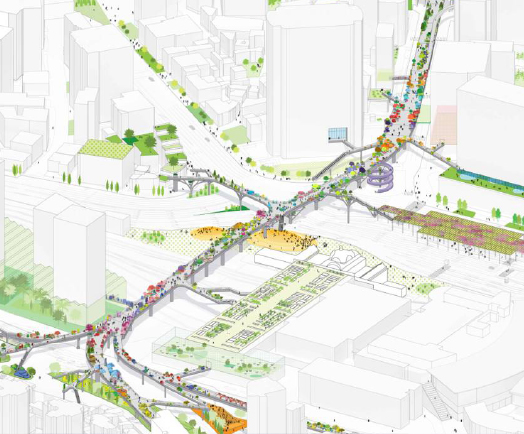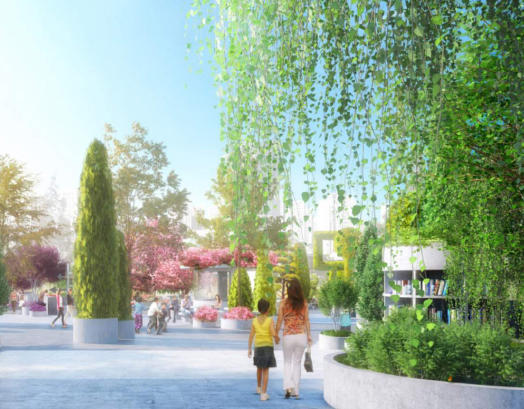Highway Greenery
A Catalyst for Revitalizing Surrounding Neighbourhoods
An old elevated highway in Seoul is about to get a new lease on life. The ambitious project, named the 'Seoul Skygarden', is scheduled to be completed in 2017. The plan is to incorporate 254 different species of trees, shrubs and flowers along the half-mile, 55-foot high former highway overpass, and the flora will be arranged in order based on the Korean alphabet. The park will be an 'urban nursery', serving as a catalyst for greening the surrounding neighbourhoods, growing trees and other plants for these neighbourhoods. A joint research study by Seoul Institute and the Korea Planner Association estimated that the project would generate 1.83 times the cost of its renovation and maintenance in economic benefits.
MVRDV, a Dutch architectural firm based in Rotterdam which designed the famously vibrant Rotterdam market, has been chosen to design the Seoul Skygarden.

Winy Maas, principal architect and co-founder of MVRDV, explains, 'The Seoul Skygarden will change the daily lives of many people in Seoul for the better: they will have a pleasant shortcut through a green oasis in the midst of all the traffic and concrete. It is a walk through a park, a living dictionary of the natural heritage of Korea, connecting the city dweller with nature.'

Local Community Support
Originally built in the 1970s, the Seoul Station Overpass provided a vehicular link from Namdaemun market, the largest traditional market in Seoul on the East side, to the luxuriant parks to the West. However, city inspectors deemed the elevated highway unsafe for vehicular traffic in 2006. The inspectors' proposal was to demolish and rebuild the highway. In 2009 the City of Seoul banned heavy vehicles' access to begin the process of decommissioning the roadway. However, residents and local experts convinced the city to regenerate the highway into a pedestrian walkway and public space. They cited research to show that such a public park space would reap economic benefits that would almost double what the park would cost to build and maintain. In 2015, a design competition was launched.
The level of community support exhibited for the project was reminiscent of New York City's extremely popular High Line public park. In the latter situation, organized community groups started a nonprofit and lobbied for the park's construction. The result was a well-loved park that revitalized the immediate neighbourhood. Another welcomed outcome was higher real estate prices.
An Oasis in the Heart of Seoul
Though impressive, the Seoul Station Overpass is by no means the world's first idea for a public park that reuses old infrastructure. The opening of New York's High Line has inspired countless copycats. From an elevated park for Washington D.C., to Thomas Heatherwick's idea for a floating park in New York, to Chicago's El Line, repurposed infrastructure is all around us.
To transform Seoul's dilapidated highway into an inviting public green oasis, circular pots of varying sizes containing different kinds of plants will be placed throughout the overpass. From the existing structural piers of the Skygarden, stairs, lifts, and escalators, as well as 'satellite gardens', representing different neighbourhoods, will sprout like branches. These neighbourhoods make the Skygarden easy to navigate due to their alphabetical order and consistent signage, and each will contain plant species different from the other neighbourhoods. The physical and visual differentiation gives each space a distinctive character.
In the future, the overpass will evolve with new plants and new activators so as to become an 'urban nursery' that rears trees for the surrounding districts. In addition to the more conceptual garden, a series of practical but attractive spaces such as tea houses, flower shops, street markets, and libraries will also be built. These functional and user-friendly spaces will invite foot traffic and bring the projected increase in revenue and intended economic benefits to this park.



